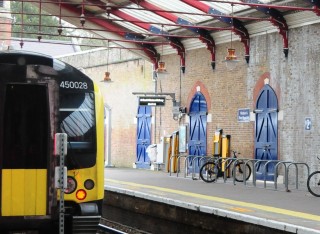
Dr Gopinath Kalaiarasan
Academic and research departments
Global Centre for Clean Air Research, School of Sustainability, Civil and Environmental Engineering, Institute for Sustainability.Publications
Particulate matter (PM) is a crucial health risk factor for respiratory and cardiovascular diseases. The smaller size fractions, ≤2.5 μm (PM2.5; fine particles) and ≤0.1 μm (PM0.1; ultrafine particles), show the highest bioactivity but acquiring sufficient mass for in vitro and in vivo toxicological studies is challenging. We review the suitability of available instrumentation to collect the PM mass required for these assessments. Five different microenvironments representing the diverse exposure conditions in urban environments are considered in order to establish the typical PM concentrations present. The highest concentrations of PM2.5 and PM0.1 were found near traffic (i.e. roadsides and traffic intersections), followed by indoor environments, parks and behind roadside vegetation. We identify key factors to consider when selecting sampling instrumentation. These include PM concentration on-site (low concentrations increase sampling time), nature of sampling sites (e.g. indoors; noise and space will be an issue), equipment handling and power supply. Physicochemical characterisation requires micro- to milli-gram quantities of PM and it may increase according to the processing methods (e.g. digestion or sonication). Toxicological assessments of PM involve numerous mechanisms (e.g. inflammatory processes and oxidative stress) requiring significant amounts of PM to obtain accurate results. Optimising air sampling techniques are therefore important for the appropriate collection medium/filter which have innate physical properties and the potential to interact with samples. An evaluation of methods and instrumentation used for airborne virus collection concludes that samplers operating cyclone sampling techniques (using centrifugal forces) are effective in collecting airborne viruses. We highlight that predictive modelling can help to identify pollution hotspots in an urban environment for the efficient collection of PM mass. This review provides guidance to prepare and plan efficient sampling campaigns to collect sufficient PM mass for various purposes in a reasonable timeframe.
A link between outdoor pollution of particulate matter (PM) and the mortality from COVID-19 disease has been reported. The potential interaction of SARS-CoV2 emitted from an infected subject in the form of droplets or as an aerosol with PM[Formula: see text] (PM of 2.5 [Formula: see text]m or less in aerodynamic diameter) may modulate SARS-CoV2 replication and infectivity. This may represent an important airborne route of transmission, which could lead to pneumonia and a poor outcome from COVID-19. Further studies are needed to assess the potential infectivity and severity of such transmission.
Indoor, airborne, transmission of SARS-CoV-2 is a key infection route. We monitored fourteen different indoor spaces in order to assess the risk of SARS-CoV-2 transmission. PM2.5 and CO2 concentrations were simultaneously monitored in order to understand aerosol exposure and ventilation conditions. Average PM2.5 concentrations were highest in the underground station (261 ± 62.8 μgm−3), followed by outpatient and emergency rooms in hospitals located near major arterial roads (38.6 ± 20.4 μgm−3), the respiratory wards, medical day units and intensive care units recorded concentrations in the range of 5.9 to 1.1 μgm−3. Mean CO2 levels across all sites did not exceed 1000 ppm, the respiratory ward (788 ± 61 ppm) and the pub (bar) (744 ± 136 ppm) due to high occupancy. The estimated air change rates implied that there is sufficient ventilation in these spaces to manage increased levels of occupancy. The infection probability in the medical day unit of hospital 3, was 1.6-times and 2.2-times higher than the emergency and outpatient waiting rooms in hospitals 4 and 5, respectively. The temperature and relative humidity recorded at most sites was below 27 °C, and 40% and, in sites with high footfall and limited air exchange, such as the hospital medical day unit, indicate a high risk of airborne SARS-CoV-2 transmission.
We compared various pollutant concentrations (PM1, PM2.5, PM10, PNC, BC) at four different urban microenvironments (MEs) in London (Indoor, IN; Traffic Intersection, TI; Park, PK; and Street Canyon, SC). The physico-chemical characteristics of particles were analysed, and the respiratory deposition doses (RDD) were estimated. Field measurements were conducted over a period of 121 days. The mean PM2.5 (PNC) concentrations were found to be 9.47 ± 7.05 (16366 ± 11815), 8.09 ± 4.57 (10951 ± 6445), 5.11 ± 2.96 (7717 ± 4576), 3.88 ± 3.06 (5672 ± 2934) μg m−3 (# cm−3) at TI, SC, PK and IN, respectively. PM2.5, PM10 and PNC exhibited a trend of TI > SC > PK > IN; higher concentrations for PM1 and BC were observed at IN than PK due to the emissions from printers, producing a trend of TI > SC > IN > PK. We observed 12%–30% higher fine PM concentrations at TI and SC sites during morning peak (07:00–09:30) than the evening peak hours (16:00–19:00); while IN showed a smaller variation in fine PM concentrations compared with outdoor TI, PK and SC sites owing to their prevalence in the IN for a longer time. Fine and ultrafine PM containing potentially toxic trace transition metals including Fe, Ti, Cr, Mn, Al and Mg were detected by high resolution electron microscopy at all sites. There was a similar relative abundance of different elements at the TI, IN and PK sites, which suggests a transport of PM between MEs. RDD for PM1 was highest (2.45 ± 2.27 μg h−1) at TI for females during running; PM2.5 and PM10 were highest at SC (11.23 ± 6.34 and 37.17 ± 20.82 μg h−1, respectively). The results show that the RDD variation between MEs does not follow the PM concentration trend. RDD at PK was found to be 39%–53% lower than TI and SC during running for all the PM fractions. Overall, the study findings show the air quality variation at different MEs and reveals the exposure inequalities around the city, which enable the management of personal exposure by selecting appropriate MEs for different activities.
https://eac2021.co.uk/
Urban Heat Island (UHI) is posing a significant challenge due to growing urbanisations across the world. Green infrastructure (GI) is popularly used for mitigating the impact of UHI, but knowledge on their optimal use is yet evolving. The UHI effect for large cities have received substantial attention previously. However, the corresponding effect is mostly unknown for towns, where appreciable parts of the population live, in Europe and elsewhere. Therefore, we analysed the possible impact of three vegetation types on UHI under numerous scenarios: baseline/current GI cover (BGI); hypothetical scenario without GI cover (HGI-No); three alternative hypothetical scenarios considering maximum green roofs (HGR-Max), grasslands (HG-Max) and trees (HT-Max) using a dispersion model ADMS-Temperature and Humidity model (ADMS-TH), taking a UK town (Guildford) as a case study area. Differences in an ambient temperature between three different landforms (central urban area, an urban park, and suburban residential area) were also explored. Under all scenarios, the night-time (0200 h; local time) showed a higher temperature increase, up to 1.315 °C due to the lowest atmospheric temperature. The highest average temperature perturbation (change in ambient temperature) was 0.563 °C under HGI-No scenario, followed by HG-Max (0.400 °C), BGI (0.343 °C), HGR-Max (0.326 °C) and HT-Max (0.277 °C). Furthermore, the central urban area experienced a 0.371 °C and 0.401 °C higher ambient temperature compared with its nearby suburban residential area and urban park, respectively. The results allow to conclude that temperature perturbations in urban environments are highly dependent on the type of GI, anthropogenic heat sources (buildings and vehicles) and the percentage of land covered by GI. Among all other forms of GI, trees were the best-suited GI which can play a viable role in reducing the UHI. Green roofs can act as an additional mitigation measure for the reduction of UHI at city scale if large areas are covered.
We estimated the particle number distributions (PNDs), particle number concentrations (PNCs), physicochemical characteristics, meteorological effects, and respiratory deposition doses (RDD) in the human respiratory tract for three different particle modes: nucleation (N6–30), accumulation (N30–300), and coarse (N300–10,000) modes. This study was conducted in three different microenvironments (MEs) in London (indoor, IN; traffic intersection, TI; park, PK) measuring particles in the range of 6 nm–10,000 nm using an electrical low-pressure impactor (ELPI+). Mean PNCs were 1.68 ± 1.03 × 104 #cm−3, 7.00 ± 18.96 × 104 #cm−3, and 0.76 ± 0.95 × 104 #cm−3 at IN, TI, and PK, respectively. The PNDs were high for nucleation-mode particles at the TI site, especially during peak traffic hours. Wind speeds ranging from 0 to 6 ms−1 exhibit higher PNCs for nucleation- and accumulation-mode particles at TI and PK sites. Physicochemical characterisation shows trace metals, including Fe, O, and inorganic elements, that were embedded in a matrix of organic material in some samples. Alveolar RDD was higher for the nucleation and accumulation modes than the coarse-mode particles. The chemical signatures from the physicochemical characterisation indicate the varied sources at different MEs. These findings enhance our understanding of the different particle profiles at each ME and should help devise ways of reducing personal exposure at each ME.
Underground railway systems are recognised spaces of increased personal pollution exposure. We studied the number-size distribution and physico-chemical characteristics of ultrafine (PM0.1), fine (PM0.1–2.5) and coarse (PM2.5–10) particles collected on a London underground platform. Particle number concentrations gradually increased throughout the day, with a maximum concentration between 18: 00 h and 21:00 h (local time). There was a maximum decrease in mass for the PM2.5, PM2.5–10 and black carbon of 3.9, 4.5 and ~ 21-times, respectively, between operable (OpHrs) and non-operable (N-OpHrs) hours. Average PM10 (52 μg m−3) and PM2.5 (34 μg m−3) concentrations over the full data showed levels above the World Health Organization Air Quality Guidelines. Respiratory deposition doses of particle number and mass concentrations were calculated and found to be two- and four-times higher during OpHrs compared with N-OpHrs, reflecting events such as train arrival/departure during OpHrs. Organic compounds were composed of aromatic hydrocarbons and polycyclic aromatic hydrocarbons (PAHs) which are known to be harmful to health. Specific ratios of PAHs were identified for underground transport that may reflect an interaction between PAHs and fine particles. Scanning transmission electron microscopy (STEM) chemical maps of fine and ultrafine fractions show they are composed of Fe and O in the form of magnetite and nanosized mixtures of metals including Cr, Al, Ni and Mn. These findings, and the low air change rate (0.17 to 0.46 h−1), highlight the need to improve the ventilation conditions.
Built-up environments limit air pollution dispersion in street canyons and lead to complex trade-offs between green infrastructure (GI) usage and its potential to reduce near-road exposure. This study evaluated the effects of an evergreen hedge on the distribution of particulate matter (PM1, PM2.5, PM10), black carbon (BC) and particle number concentrations (PNCs) in a street canyon in West London. Instrumentation was deployed around the hedge at 13 fixed locations to assess the impact of the hedge on vertical and horizontal concentration distributions. Changes in concentrations behind the hedge were measured with reference to the corresponding sampling point in front of the hedge for all sets of measurements. Results showed a significant reduction in vertical concentrations between 1 and 1.7 m height, with maximum reductions of –16% (PM1 and PM10) and –17% (PM2.5) at ∼1 m height. Horizontal concentrations revealed two zones between the building façade and the hedge, with opposite trends: (i) close to hedge (within 0.2 m), where a reduction of PM1 and PM2.5 was observed, possibly due to dilution, deposition and the barrier effect; and (ii) 0.2–3 m from the hedge, showing an increase of 13–37% (PM1) and 7–21% (PM2.5), possibly due to the blockage effect of the building, restricting dispersion. BC showed a significant reduction at breathing height (1.5 m) of between –7 and –50%, followed by –15% for PNCs in the 0.02–1 µm size range. The ELPI + analyser showed a peak of ∼30 nm. The presence of the hedge led to a ∼39 ± 32% decrease in total PNCs (0.006–10 µm), suggesting a greater removal in different modes, such as a 83 ± 12% reduction in nucleation mode (0.006–0.030 µm), 74 ± 15% in ultrafine (≤0.1 µm), and 34 ± 30% in accumulation mode (0.03–0.3 µm). These findings indicate graded filtering of particles by GI in a near-road street canyon environment. This insight will guide the improved design of GI barriers and the validation of microscale dispersion models.

